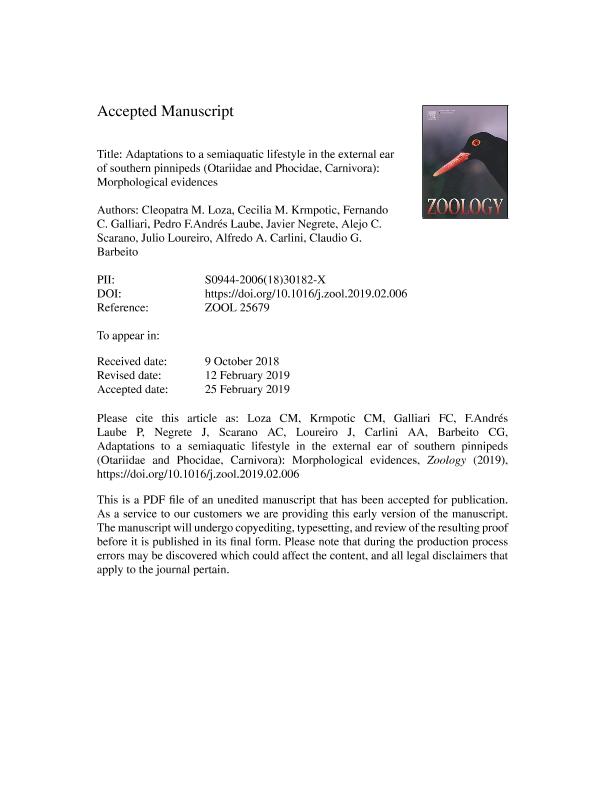Mostrar el registro sencillo del ítem
dc.contributor.author
Loza, Cleopatra Mara

dc.contributor.author
Krmpotic, Cecilia Mariana

dc.contributor.author
Galliari, Fernando Carlos

dc.contributor.author
Andrés Laube, Pedro F.
dc.contributor.author
Negrete, Javier

dc.contributor.author
Scarano, Alejo Carlos

dc.contributor.author
Loureiro, Julio
dc.contributor.author
Carlini, Alfredo Armando

dc.contributor.author
Barbeito, Claudio Gustavo

dc.date.available
2020-11-26T13:55:11Z
dc.date.issued
2019-04
dc.identifier.citation
Loza, Cleopatra Mara; Krmpotic, Cecilia Mariana; Galliari, Fernando Carlos; Andrés Laube, Pedro F.; Negrete, Javier; et al.; Adaptations to a semiaquatic lifestyle in the external ear of southern pinnipeds (Otariidae and Phocidae, Carnivora): Morphological evidences; Elsevier Gmbh; Zoology; 133; 4-2019; 66-80
dc.identifier.issn
0944-2006
dc.identifier.uri
http://hdl.handle.net/11336/119060
dc.description.abstract
Pinnipeds are semiaquatic carnivorans that spend most of their lives in water and use coastal terrestrial, or ice pack, environments to breed, molt and rest. Certain characteristics of the ear have been linked to ecological aspects. In our contribution we focus on the study of the macroscopic and microscopic morphology of the external ear (with the exception of the osseous outer ear canal) of six species of Southern pinnipeds. In order to recognize the different components of tissues, sections were stained following several routine protocols. In addition, double-staining and enzymatic clearing (Alcian blue-alizarin red) was performed to assess the arrangement of skeletal elements in the OEC. The basic structure of the pinna in the southern otariids studied match those previously analyzed for Northern Hemisphere species. The cartilage macro anatomy of the OEC of Mirounga leonina and Arctocephallus gazella is different from that of the Northern Hemisphere species, with only one plate of cartilage, but markedly different between them. The histology of the otariids OEC is homogeneous along the entire extension, but phocids has three different regions (distal, middle, and proximal). The cartilage histology of most phocids is also different from that of analyzed otariids, with an elastic cartilage that resembles a myxoid-like tissue, but is not present in M. leonina, were the tissue around the OEC is very rich in adipocytes. The southern elephant seal M. leonina OEC has a combination of features similar to both the rest of the phocids and to the otariids. An auditory organ that is functional both over and under water could be essential for social behavior in these species.
dc.format
application/pdf
dc.language.iso
eng
dc.publisher
Elsevier Gmbh

dc.rights
info:eu-repo/semantics/openAccess
dc.rights.uri
https://creativecommons.org/licenses/by-nc-nd/2.5/ar/
dc.subject
SOUTHERN SEALS
dc.subject
FUR SEALS
dc.subject
MYXOID TISSUE
dc.subject
EXTERNAL EARHISTOLOGY
dc.subject.classification
Biología Marina, Limnología

dc.subject.classification
Ciencias Biológicas

dc.subject.classification
CIENCIAS NATURALES Y EXACTAS

dc.title
Adaptations to a semiaquatic lifestyle in the external ear of southern pinnipeds (Otariidae and Phocidae, Carnivora): Morphological evidences
dc.type
info:eu-repo/semantics/article
dc.type
info:ar-repo/semantics/artículo
dc.type
info:eu-repo/semantics/publishedVersion
dc.date.updated
2020-11-19T15:50:17Z
dc.journal.volume
133
dc.journal.pagination
66-80
dc.journal.pais
Alemania

dc.description.fil
Fil: Loza, Cleopatra Mara. Consejo Nacional de Investigaciones Científicas y Técnicas; Argentina. Universidad Nacional de la Plata. Facultad de Cs.naturales y Museo. Laboratorio de Morfologia Evolutiva y Desarrollo.; Argentina. Universidad Nacional de La Plata. Facultad de Ciencias Naturales y Museo. División Paleontología Vertebrados; Argentina
dc.description.fil
Fil: Krmpotic, Cecilia Mariana. Consejo Nacional de Investigaciones Científicas y Técnicas; Argentina. Universidad Nacional de La Plata. Facultad de Ciencias Naturales y Museo. División Paleontología Vertebrados; Argentina. Universidad Nacional de la Plata. Facultad de Cs.naturales y Museo. Laboratorio de Morfologia Evolutiva y Desarrollo.; Argentina
dc.description.fil
Fil: Galliari, Fernando Carlos. Universidad Nacional de La Plata. Facultad de Ciencias Naturales y Museo. División Paleontología Vertebrados; Argentina. Consejo Nacional de Investigaciones Científicas y Técnicas; Argentina. Universidad Nacional de la Plata. Facultad de Cs.naturales y Museo. Laboratorio de Morfologia Evolutiva y Desarrollo.; Argentina
dc.description.fil
Fil: Andrés Laube, Pedro F.. Universidad Nacional de La Plata. Facultad de Ciencias Veterinarias; Argentina
dc.description.fil
Fil: Negrete, Javier. Consejo Nacional de Investigaciones Científicas y Técnicas; Argentina. Ministerio de Relaciones Exteriores, Comercio Interno y Culto. Dirección Nacional del Antártico. Instituto Antártico Argentino; Argentina
dc.description.fil
Fil: Scarano, Alejo Carlos. Universidad Nacional de La Plata. Facultad de Ciencias Naturales y Museo. División Paleontología Vertebrados; Argentina. Universidad Nacional de la Plata. Facultad de Cs.naturales y Museo. Laboratorio de Morfologia Evolutiva y Desarrollo.; Argentina. Consejo Nacional de Investigaciones Científicas y Técnicas; Argentina. Universidad Nacional de Avellaneda; Argentina
dc.description.fil
Fil: Loureiro, Julio. No especifíca;
dc.description.fil
Fil: Carlini, Alfredo Armando. Universidad Nacional de La Plata. Facultad de Ciencias Naturales y Museo. División Paleontología Vertebrados; Argentina. Consejo Nacional de Investigaciones Científicas y Técnicas; Argentina. Universidad Nacional de la Plata. Facultad de Cs.naturales y Museo. Laboratorio de Morfologia Evolutiva y Desarrollo.; Argentina
dc.description.fil
Fil: Barbeito, Claudio Gustavo. Universidad Nacional de La Plata; Argentina. Consejo Nacional de Investigaciones Científicas y Técnicas; Argentina
dc.journal.title
Zoology

dc.relation.alternativeid
info:eu-repo/semantics/altIdentifier/url/https://linkinghub.elsevier.com/retrieve/pii/S094420061830182X
dc.relation.alternativeid
info:eu-repo/semantics/altIdentifier/doi/http://dx.doi.org/10.1016/j.zool.2019.02.006
Archivos asociados
